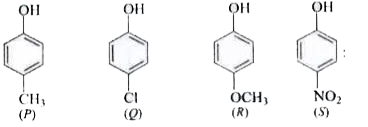The decreasing order of acidic character of the following is :
(I) p-Nitrophenol
(II) o-Nitrophenol
(III) m-Nitrophenol
(IV) Phenol.
I>II>III>IV
II>I>III>IV
I>II>IV>III
II>I>IV>III
To determine the decreasing order of acidic character among p-Nitrophenol (I), o-Nitrophenol (II), m-Nitrophenol (III), and Phenol (IV), we can follow these steps:
Step 1: Understand the Structures
- Phenol (IV): Contains a hydroxyl group (-OH) attached to a benzene ring.
- p-Nitrophenol (I): Contains a nitro group (-NO2) at the para position relative to the hydroxyl group.
- o-Nitrophenol (II): Contains a nitro group at the ortho position relative to the hydroxyl group.
- m-Nitrophenol (III): Contains a nitro group at the meta position relative to the hydroxyl group.
Step 2: Analyze the Effects of the Nitro Group
The nitro group is a strong electron-withdrawing group due to its -I (inductive) and -R (resonance) effects.
- The -R effect is stronger than the -I effect for the nitro group, which means it has a significant impact on the acidity of the compounds.
Step 3: Compare the Acidity
1. Phenol (IV): The least acidic because it does not have any electron-withdrawing groups to stabilize the negative charge on the phenoxide ion formed after deprotonation.
2. m-Nitrophenol (III): The nitro group at the meta position has a weaker -R effect compared to the ortho and para positions, resulting in less stabilization of the phenoxide ion.
3. o-Nitrophenol (II): The nitro group at the ortho position can stabilize the phenoxide ion through resonance, but it also experiences intramolecular hydrogen bonding, which makes the loss of the proton slightly more difficult.
4. p-Nitrophenol (I): The nitro group at the para position stabilizes the phenoxide ion through resonance without the interference of intramolecular hydrogen bonding, making it the most acidic.
Step 4: Final Order of Acidity
Based on the analysis, the decreasing order of acidic character is:
1. p-Nitrophenol (I)
2. o-Nitrophenol (II)
3. m-Nitrophenol (III)
4. Phenol (IV)
Conclusion
Thus, the final answer is:
p-Nitrophenol > o-Nitrophenol > m-Nitrophenol > Phenol
---
- Phenol (IV): Contains a hydroxyl group (-OH) attached to a benzene ring.
- p-Nitrophenol (I): Contains a nitro group (-NO2) at the para position relative to the hydroxyl group.
- o-Nitrophenol (II): Contains a nitro group at the ortho position relative to the hydroxyl group.
- m-Nitrophenol (III): Contains a nitro group at the meta position relative to the hydroxyl group.
The nitro group is a strong electron-withdrawing group due to its -I (inductive) and -R (resonance) effects.
- The -R effect is stronger than the -I effect for the nitro group, which means it has a significant impact on the acidity of the compounds.
1. Phenol (IV): The least acidic because it does not have any electron-withdrawing groups to stabilize the negative charge on the phenoxide ion formed after deprotonation.
2. m-Nitrophenol (III): The nitro group at the meta position has a weaker -R effect compared to the ortho and para positions, resulting in less stabilization of the phenoxide ion.
3. o-Nitrophenol (II): The nitro group at the ortho position can stabilize the phenoxide ion through resonance, but it also experiences intramolecular hydrogen bonding, which makes the loss of the proton slightly more difficult.
4. p-Nitrophenol (I): The nitro group at the para position stabilizes the phenoxide ion through resonance without the interference of intramolecular hydrogen bonding, making it the most acidic.
Based on the analysis, the decreasing order of acidic character is:
1. p-Nitrophenol (I)
2. o-Nitrophenol (II)
3. m-Nitrophenol (III)
4. Phenol (IV)
Thus, the final answer is:
p-Nitrophenol > o-Nitrophenol > m-Nitrophenol > Phenol
Topper's Solved these Questions
- GENERAL ORGANIC CHEMISTRYBOOK - CENGAGE CHEMISTRY ENGLISHCHAPTER - GENERAL ORGANIC CHEMISTRYEXERCISE - Assertion-Reasoning
5 Videos
- GENERAL ORGANIC CHEMISTRYBOOK - CENGAGE CHEMISTRY ENGLISHCHAPTER - GENERAL ORGANIC CHEMISTRYEXERCISE - Archives
12 Videos
- GENERAL ORGANIC CHEMISTRYBOOK - CENGAGE CHEMISTRY ENGLISHCHAPTER - GENERAL ORGANIC CHEMISTRYEXERCISE - Multiple Correct
22 Videos
- CLASSIFICATION AND NOMENCLATURE OF ORGANIC COMPOUNDSBOOK - CENGAGE CHEMISTRY ENGLISHCHAPTER - CLASSIFICATION AND NOMENCLATURE OF ORGANIC COMPOUNDSEXERCISE - Analytical and Descriptive Type
3 Videos
- HYDROGEN, WATER AND HYDROGEN PEROXIDEBOOK - CENGAGE CHEMISTRY ENGLISHCHAPTER - HYDROGEN, WATER AND HYDROGEN PEROXIDEEXERCISE - Subjective Archive (Subjective)
3 Videos
Similar Questions
Knowledge Check
The decreasing order of acidity of following phenol derivatives is
 AS>P>Q>RBR>S>P>QCS>Q>P>RDP>Q>R>S
AS>P>Q>RBR>S>P>QCS>Q>P>RDP>Q>R>SThe decreasing order of acidity of following phenol derivatives is
 AR>P>Q>SBP>R>Q>SCR>Q>P>SDS>Q>P>R
AR>P>Q>SBP>R>Q>SCR>Q>P>SDS>Q>P>RThe decreasing order of acidity of following phenol derivatives is
 AP>Q>R>SBS>R>Q>PCS>R>P>QDQ>S>R>P
AP>Q>R>SBS>R>Q>PCS>R>P>QDQ>S>R>P
o-nitrophenol is
View SolutionThe decreasing order of basic characters of the following is :
(I) Aniline
(II) o-Nitroaniline
(III) m-Nitroaniline
(IV) p-Nitroaniline.
View SolutionThe decreasing order of acidic character of the following is :
(I) CH3SH
(II) CH3OH
(III) H2O
(IV) EtOH.
View SolutionThe decreasing order of acidic character of the following is:
(I) EtOH
(II) Me−COOH
MeOOC−CH2−COOMe
(IV)
View SolutionThe decreasing order of acidity of following phenol derivatives is

View Solution


 (II)
(II) 
 (IV)
(IV) 